Question
Could you please assist me in rewriting this assignment? I've attempted to follow the professor's instructions, and I've included both my initial attempt and the
Could you please assist me in rewriting this assignment? I've attempted to follow the professor's instructions, and I've included both my initial attempt and the feedback I received. Your help in refining and completing the assignment as per the professor's guidance would be greatly appreciated.
Exam Questions - Assignment #8
Tralfamadorean scientists have made an exciting discovery! The Tralfamadorean brain appears to have a special extrastriate visual area that specifically responds to images of hands. That is, images of hands in all different poses tend to elicit a large response from this area, while other object images (things like airplanes, writing implements, etc.) do not.
(A) Considering what hands tend to look like, suggest at least two simpler shape properties that this visual area might be sensitive to rather than being a "hand area" per se.
(B) For each of the two properties that you mentioned in (A), suggest a set of control images that you could include in a new fMRI task to test the hypothesis that this area is NOT sensitive to hands.
(C) You know that the Tralfmadoreans have a very low-resolution fMRI scanner and you also know that the new hand area seems to be in about the same neighborhood as the human body area. Discuss how their results could be an artifact of a low resolution scanner and predict what they might find if they used a higher-resolution instrument.
My initial attempt:
(A) Two simpler shape properties that the Tralfamadorean brain's visual area might be sensitive to:
Curvature: This refers to the amount of bending or deviation from a straight line in an object's shape. Hands, with their fingers and joints, exhibit a unique curvature that can be distinguished from many other objects. The brain's sensitivity to curvature could be a fundamental aspect of how it processes visual information.
Complexity of Contours it involves the intricacy and convolutions in the outline or boundary of an object. Hands have complex contours with features like fingers, nails, and joints, contributing to a visually intricate pattern. Sensitivity to the complexity of contours could be a key factor in the visual processing of distinct objects.
(B) Control images for testing the hypothesis that the area is NOT sensitive to hands:
Curved Objects: Select images of objects with prominent curvature that is not characteristic of hands. Examples could include bananas, snakes, or curving roads. If the visual area responds similarly to these control images as it does to hands, it suggests that the sensitivity is not specific to hands but rather to curvature.
Complex Contours: Present images of objects with complex contours that do not resemble hands. This could include images of tree branches, coral reefs, or intricate patterns. If the visual area responds similarly to these control images as it does to hands, it indicates sensitivity to complex contours rather than hands specifically.
(C) Potential artifacts of a low-resolution scanner and predictions for a higher-resolution instrument:
Increased Spatial Precision: A low-resolution scanner may not capture fine details, leading to overlapping activation patterns. With a higher-resolution instrument, the Tralfamadorean scientists could discern more precise spatial information, allowing them to isolate and analyze the activation specific to hands. This would help confirm or disprove the hypothesis of a specialized hand area.
Fine-grained Discrimination: Higher resolution would enable the scientists to investigate the response of the visual area to finer details of hand anatomy, such as individual fingers and joints. This level of discrimination would provide insights into whether the observed sensitivity is due to a general response to curvature or complex contours, or if it is indeed specific to hands.
Professor from feedback:
I'd like a little more detail in (C). I agree with what you're saying, but what I want you to think about is what less accurate spatial resolution might mean in this context. If resolution means being able to distinguish between things that are very close together, what is a mistake we might be making or something we might be missing with a low resolution scanner in terms of the body area and a possible hand area? Please include some discussion of this in a revision.
Step by Step Solution
There are 3 Steps involved in it
Step: 1

Get Instant Access to Expert-Tailored Solutions
See step-by-step solutions with expert insights and AI powered tools for academic success
Step: 2

Step: 3

Ace Your Homework with AI
Get the answers you need in no time with our AI-driven, step-by-step assistance
Get Started


